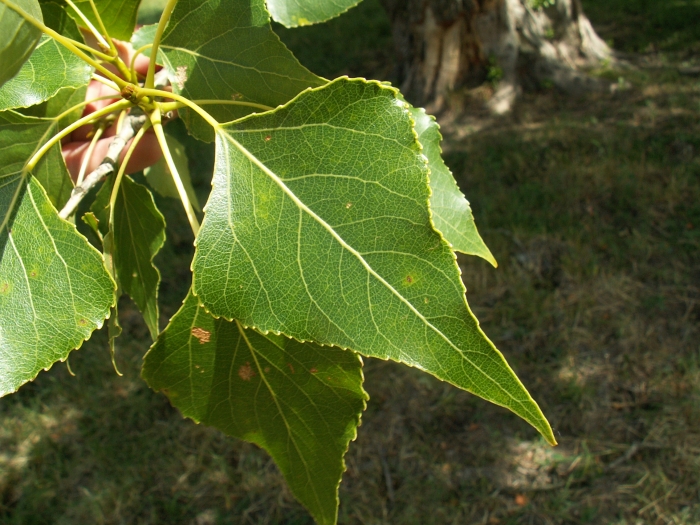Black Poplar
(Populus nigra)
Black Poplar (Populus nigra)
/
/

Krzysztof Ziarnek, Kenraiz
CC BY-SA 4.0
Image By:
Krzysztof Ziarnek, Kenraiz
Recorded By:
Copyright:
CC BY-SA 4.0
Copyright Notice:
Photo by: Krzysztof Ziarnek, Kenraiz | License Type: CC BY-SA 4.0 | License URL: https://creativecommons.org/licenses/by-sa/4.0 | Uploader: Kenraiz | Publisher: Wikimedia Commons | Title: Populus_nigra_kz03.jpg | Notes: User created page with UploadWizard |

















































































Estimated Native Range
Summary
Populus nigra, commonly known as Black Poplar, is a deciduous tree native to riparian zones, floodplains, and wetlands from Europe and northern Africa to central Asia. It typically grows to a height of 20–30 meters, and on rare occasions, up to 40 meters, with trunks reaching up to 1.5 meters in diameter. The Black Poplar is dioecious, with male and female flowers on separate plants, presenting as catkins that rely on wind for pollination. Its leaves are diamond-shaped and turn yellow in the fall, providing seasonal interest. The bark is deeply fissured and adds a rugged texture to the landscape.
This species thrives in full sun and requires high amounts of water, making it suitable for planting in areas with moist soils, including those with slow, medium, or fast drainage. Black Poplar is often used for biomass production and erosion control due to its rapid growth and ability to quickly colonize open areas. It also serves as an important habitat for wildlife. However, it can be potentially invasive outside its native range, including in the United States, and may pose problems with aggressive root systems that can damage pavements and underground utilities. Gardeners should check local regulations before planting and consider containment measures if necessary.CC BY-SA 4.0
This species thrives in full sun and requires high amounts of water, making it suitable for planting in areas with moist soils, including those with slow, medium, or fast drainage. Black Poplar is often used for biomass production and erosion control due to its rapid growth and ability to quickly colonize open areas. It also serves as an important habitat for wildlife. However, it can be potentially invasive outside its native range, including in the United States, and may pose problems with aggressive root systems that can damage pavements and underground utilities. Gardeners should check local regulations before planting and consider containment measures if necessary.CC BY-SA 4.0
Plant Description
- Plant Type: Trees
- Height: 60-100 feet
- Width: 30-50 feet
- Growth Rate: Rapid
- Flower Color: N/A
- Flowering Season: Spring
- Leaf Retention: Deciduous
Growth Requirements
- Sun: Full Sun
- Water: High
- Drainage: Fast, Medium, Slow
Common Uses
Bank Stabilization, Bee Garden, Bird Garden, Butterfly Garden, Fire Resistant, Salt Tolerant, Water Garden
Natural Habitat
Riparian zones, floodplains, and wetlands in Eastern Europe, the Middle East, and Western Asia
Other Names
Common Names: Lombardy Poplar, Black Cottonwood, Schwarz-Pappel, Schwarzpappel, Peuplier Noir, Zwarte Populier, Svartpoppel, Osokor, Topol’ ČErnyj, Hei Yang, 양버들
Scientific Names: , Populus nigra, Populus canadensis, Populus nigra var. italica, Populus nigra subsp. betulifolia, Populus nigra subsp. neapolitana, Populus nigra var. betulifolia, Populus pyramidalis, Populus nigra var. elegans, Populus nigra subsp. caudina
GBIF Accepted Name: Populus nigra L.